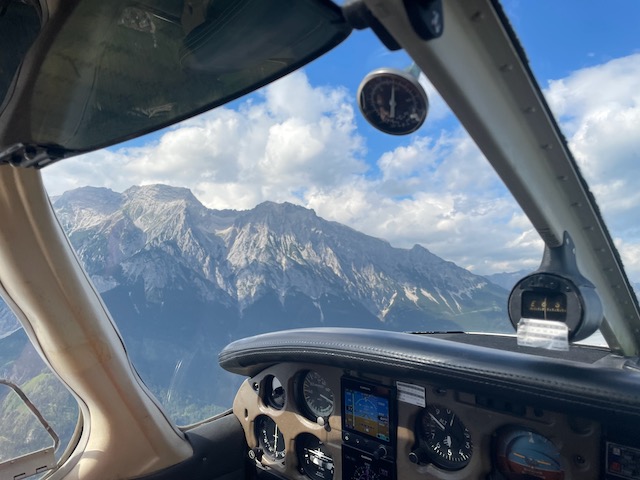
Learning to fly in the Alps
If you want to fly to Italy or beyond from Germany, you need to cross the Alps. Not every day lends itself to overfly them in the flight levels. Sometimes, you need to fly through mountain passes. But how do you do that safely?
I didn’t just want to go for it. So in April I booked an Alps flying course in Kempten (EDMK).
Disclaimer: I am not a flight instructor. This is a report of what I’ve learnt, and not advise. Please talk to an experienced flight instructor, if you plan on doing mountain flying.
Route
Because of some weather coming in from the east, we needed to abbreviate our route, and were not able to land anywhere on the way.
Our Route took us through a couple of beautiful valleys and passes in Switzerland, over Davos to Samaden. From there we flew east over Livogno in Italy, then passed Ischgl and Lech in Austria on our way back to Kempten.
All in all the whole flight took us 2:51 hours, with a maximum altitude of 10.990ft MSL and an average ground speed of 86kt.
Navigation
Flying without a clear picture of the route in the mountains is very dangerous. You can find yourself flying into the wrong pass only to have the terrain rise quickly and the valley narrowing. This can easily become a death trap, when the plane can’t out climb the mountain.
Before we set off, we planed our route. For every turn into a valley or pass, we wrote down the heading for flying into the pass, the minimum altitude and the estimated time. This way we can always double check if made the correct turn. Before flying into a valley, we always verified:
- that there were no clouds in the way
- that there were no obstacles like power lines, chair lifts, etc.
- that there was no other traffic
- landmarks like roads, rivers, villages, lakes, etc were there as expected
Another important aspect is to always have a plan B. Things don’t always work as expected, always know how to get out the current situation.
Flying
The first skill we practice in the air was turing around tightly. We flew parallel to an Autobahn, which was just off to my left. I slowed the C172P down to 80 knots, added flaps and did a 30° turn. This felt a bit weird, but it was very effective. Instead of crossing the Autobahn on my 180, it was now to my right.
This is a very important technique to master, since when flying into a wrong valley, turing around quickly could be your only way out.
When flying, we always keep to the right of the valley. This allows us to avoid opposite traffic and gives us a lot more space for turns. When making a turn into a pass on the right, we flew to the opposite side, in order to have a good look, then made the turn and moved back to the right.
You can always expect other traffic like glider and hang gliders in the mountains, so you should be constantly scanning your surroundings. When climbing, you should keep the pitch very low, in order to maintain good forward visibility.
Some tramways have cables running very high above ground, and are virtually impossible to see. Prepare well, and don’t take any shortcuts.
When crossing ridges, do so in a 45° angle. This allows you to abandon the crossing quickly, in case of clouds or down drafts.
Other topics
We also discussed a lot of other topics, like:
- Weather: up and down drafts, Föhn, etc.
- Landing and departing in high elevation or density altitude
- Emergency procedures
- Flight plan and customs for Switzerland
I can only recommend this sort of training. It gave me a lot of confidence and I actually did fly out into the alps with a friend afterwards, and I will hopefully be doing so more in the future.